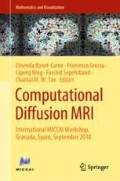Abstract
We present a new framework for the creation of an extended atlas of short fiber bundles between 20 and 80 mm length. This method uses a Diffeomorphic inter-subject alignment procedure including information of cortical foldings and forces the accurate match of the sulci that have to be circumvented by the U-bundles. Then, a clustering is performed to extract the most reproducible bundles across subjects. First results show an increased number of U-bundles consistently mapped in the general population compared with previous atlases created from the same database. Future analysis over this new extended Brain atlas may improve our understanding of the relationship between the folding pattern and the U-bundle variability. The ultimate aim will be the possibility to detect abnormal configurations induced by developmental issues.
This project has received funding from the European Union’s Horizon 2020 Research and Innovation Programme under Grant Agreement No. 785907 (HBP SGA2).
Access this chapter
Tax calculation will be finalised at checkout
Purchases are for personal use only
References
Ashburner, J., et al.: A fast diffeomorphic image registration algorithm. Neuroimage 38(95), 113 (2007)
Assaf, Y., et al.: The CONNECT project: combining macro- and micro-structure. Neuroimage 80, 273–282 (2013)
Auzias, G., et al.: Diffeomorphic brain registration under exhaustive sulcal constraints. IEEE Trans. Med. Imaging 30(6), 1214–1227 (2011)
Brainvisa Homepage. http://brainvisa.info/web/index.html. Last accessed 6 July 2018
Cointepas, Y., et al.: BrainVISA: software platform for visualization and analysis of multi-modality brain data. In: OHBM. Presented at the OHBM, Brighton (2001)
Dubois, J., et al.: Correction strategy for diffusion-weighted images corrupted with motion: application to the DTI evaluation of infants white matter. Magn. Reson. Imaging 32(8), 981–992 (2014)
Duclap, D., et al.: Connectomist-2.0: a novel diffusion analysis toolbox for BrainVISA. In: 29th ESMRMB, Lisbonne, Portugal (2012)
Descoteaux, M., et al.: Regularized, fast and robust analytical Q-ball imaging. Magn. Reson. Med. 58, 497–510 (2007)
Ester, M., et al.: A density-based algorithm for discovering clusters a density-based algorithm for discovering clusters in large spatial databases with noise. In: Proceedings of the 2nd International Conference on Knowledge Discovery and Data Mining KDD 1996, Portland, Oregon, pp. 226–231 (1996)
Fischer, C., et al.: Morphologist 2012: the new morphological pipeline of BrainVISA. In: OHBM. Presented at the OHBM, Beijing, China (2012)
Guevara, P., et al.: Robust clustering of massive tractography datasets. Neuroimage 54(3), 1975–1993 (2011)
Guevara, P., et al.: Automatic fiber bundle segmentation in massive tractography datasets using a multi-subject bundle atlas. Neuroimage 61(4), 1083–1099 (2012)
Guevara, M., et al.: Reproducibility of superficial white matter tracts using diffusionweighted imaging tractography. Neuroimage 147, 703–725 (2017)
Lebenberg, J., et al.: A framework based on sulcal constraints to align preterm, infant and adult human brain images acquired in vivo and post mortem (2018)
Mangin, J.-F., et al.: A framework to study the cortical folding patterns. Neuroimage 23(1), 129–138 (2004)
Mazziotta, J., et al.: A probabilistic atlas and reference system for the human brain: international consortium for brain mapping (ICBM). Philos. Trans. R. Soc. Lond. Ser. B 356, 1293–1322 (2001)
O’Donnell, L., et al.: Automatic tractography segmentation using a high-dimensional white matter atlas. IEEE Trans. Med. Imaging 26(11), 1562–1575 (2007)
Roman, C., et al.: Clustering of whole brain white matter short association bundles using HARDI data. Front. Neuroinformatics 11, 73 (2017)
Zhang, F., et al.: Whole brain white matter connectivity analysis using machine learning: an application to autism. Neuroimage 172, 826–837 (2018)
Author information
Authors and Affiliations
Corresponding author
Editor information
Editors and Affiliations
Rights and permissions
Copyright information
© 2019 Springer Nature Switzerland AG
About this paper
Cite this paper
Avila, N.L. et al. (2019). Inference of an Extended Short Fiber Bundle Atlas Using Sulcus-Based Constraints for a Diffeomorphic Inter-subject Alignment. In: Bonet-Carne, E., Grussu, F., Ning, L., Sepehrband, F., Tax, C. (eds) Computational Diffusion MRI. MICCAI 2019. Mathematics and Visualization. Springer, Cham. https://doi.org/10.1007/978-3-030-05831-9_25
Download citation
DOI: https://doi.org/10.1007/978-3-030-05831-9_25
Published:
Publisher Name: Springer, Cham
Print ISBN: 978-3-030-05830-2
Online ISBN: 978-3-030-05831-9
eBook Packages: Mathematics and StatisticsMathematics and Statistics (R0)

